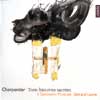Charpentier Trois histoires sacrées
View record and artist detailsRecord and Artist Details
Composer or Director: Marc-Antoine Charpentier
Genre:
Vocal
Label: Astrée Naïve
Magazine Review Date: 7/2001
Media Format: CD or Download
Media Runtime: 68
Mastering:
DDD
Catalogue Number: E8821

Tracks:
| Composition | Artist Credit |
|---|---|
| Dialogus inter angelum et pastores |
Marc-Antoine Charpentier, Composer
(Il) Seminario Musicale Gérard Lesne, Alto Jean-Francois Novelli, Tenor Marc-Antoine Charpentier, Composer Ronan Nédélec, Bass |
| Mors Saulis et Jonathae, 'Cum essent congregata ad |
Marc-Antoine Charpentier, Composer
(Il) Seminario Musicale Benjamin Clee, Alto Gérard Lesne, Alto Jaël Azzaretti, Soprano Jean-Francois Novelli, Tenor Marc-Antoine Charpentier, Composer Marie-Louise Duthoit, Soprano Nicholas Bauchau, Tenor Raimonds Spogis, Bass Ronan Nédélec, Bass |
| Sacrificium Abrahae |
Marc-Antoine Charpentier, Composer
(Il) Seminario Musicale Benjamin Clee, Alto Gérard Lesne, Alto Jaël Azzaretti, Soprano Jean-Francois Novelli, Tenor Marc-Antoine Charpentier, Composer Marie-Louise Duthoit, Soprano Nicholas Bauchau, Tenor Raimonds Spogis, Bass |
Author:
This recording offers another admirable example of the spirit of collaboration that exists today between French musicologists and performers. Catherine Cessac, the foremost French authority on Charpentier, has prepared the editions and provided the booklet essay while the French countertenor, Gerard Lesne, an experienced interpreter of 17th- century French music, together with the other members of Il Seminario Musicale, brings Charpentier’s three miniature oratorios vividly to life. Two of the histoires sacrees have been recorded for the first time: Sacrificium Abrahae and Dialogus inter angelum et pastores.
Modelled on the historiae sacrae of his presumed teacher in Rome, Carissimi, Charpentier’s works employ narrators – sometimes a solo voice, sometimes the chorus – in a highly dramatic series of instrumental (flutes, violins and continuo) and vocal movements, carefully tinged with suspensions and chromatic inflections. Both Mors Saulis et Jonathae (musically related to Charpentier’s later sacred opera, David et Jonathas) and Sacrificium Abrahae rely on tightly constructed dialogues cast in recitative. Lesne intensifies the characterisation by associating particular combinations of continuo instruments and organ stops with each of the interlocutors (listen, for example, to the witch Maga or Samuel in the first part of MSJ). Melodic, melismatic movements are reserved for moments of powerful emotion, as when David weeps for his brother Saul (second part of MSJ). Duets within the dialogues also signal key moments in the dramas as, for example, when Isaac and Abraham sing of the blessed who fear the Lord just before Abraham reveals to his son that he is to be sacrificed.
Although Il Seminario Musicale take pride in performing without a conductor, they would not produce the precision of ensemble so evident in this recording but for the vigilance of the continuo players. The absence of a principal interpreter is audible and here, as in less complex chamber music, the effect is highly desirable. Lesne delivers a string of inspiring performances in a raft of roles – the witch and the soldier in MSJ, Isaac in Sacrificium Abrahae and the angel in the Dialogus inter angelum et pastores, as do the tenor Jean-Francois Novelli as David and Abraham and the bass Raimonds Spogis as Samuel. This recording is definitely going on my list of this year’s favourites
Modelled on the historiae sacrae of his presumed teacher in Rome, Carissimi, Charpentier’s works employ narrators – sometimes a solo voice, sometimes the chorus – in a highly dramatic series of instrumental (flutes, violins and continuo) and vocal movements, carefully tinged with suspensions and chromatic inflections. Both Mors Saulis et Jonathae (musically related to Charpentier’s later sacred opera, David et Jonathas) and Sacrificium Abrahae rely on tightly constructed dialogues cast in recitative. Lesne intensifies the characterisation by associating particular combinations of continuo instruments and organ stops with each of the interlocutors (listen, for example, to the witch Maga or Samuel in the first part of MSJ). Melodic, melismatic movements are reserved for moments of powerful emotion, as when David weeps for his brother Saul (second part of MSJ). Duets within the dialogues also signal key moments in the dramas as, for example, when Isaac and Abraham sing of the blessed who fear the Lord just before Abraham reveals to his son that he is to be sacrificed.
Although Il Seminario Musicale take pride in performing without a conductor, they would not produce the precision of ensemble so evident in this recording but for the vigilance of the continuo players. The absence of a principal interpreter is audible and here, as in less complex chamber music, the effect is highly desirable. Lesne delivers a string of inspiring performances in a raft of roles – the witch and the soldier in MSJ, Isaac in Sacrificium Abrahae and the angel in the Dialogus inter angelum et pastores, as do the tenor Jean-Francois Novelli as David and Abraham and the bass Raimonds Spogis as Samuel. This recording is definitely going on my list of this year’s favourites
Discover the world's largest classical music catalogue with Presto Music.

Gramophone Digital Club
- Digital Edition
- Digital Archive
- Reviews Database
- Full website access
From £8.75 / month
Subscribe
Gramophone Full Club
- Print Edition
- Digital Edition
- Digital Archive
- Reviews Database
- Full website access
From £11.00 / month
Subscribe
If you are a library, university or other organisation that would be interested in an institutional subscription to Gramophone please click here for further information.




